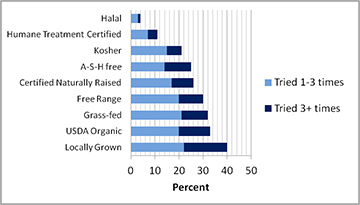Kentucky Ag News
Survey shows strong demand for local meat
University of Kentucky College of Agriculture
LEXINGTON, Ky. – A survey of meat consumers in Illinois, Indiana, Kentucky, Ohio, and Tennessee indicated very strong interest and use of locally produced meats. The survey included responses from 2,620 consumers in the region, exploring meat consumption and shopping patterns.
Consumers indicated relatively high levels of consumption frequency of local products; 39 percent had consumed some kind of locally produced meat product within the last 12 months, including 18 percent that had consumed these products more than three times. Results indicate that “locally grown” meat was tried more than any of the other common aspects of differentiation within the direct meat marketing strategy mix, including USDA Organic, grass-fed, and free range products. Figure 1 provides a summary of these results.

There have been considerable efforts to expand the availability of local meat products throughout the region in recent years. Local meat, however, is an extremely challenging enterprise to develop within most local food systems. Issues include logistics and transportation costs, processing costs, access to USDA inspected processing facilities, inventory management (such as too much ground beef and not enough steak), and variability of production/quality.
Another issue is the choice of a marketing method. Direct marketing methods may be expensive in terms of time. Also, consumers generally identify local butcher shops and smaller grocers as places where they expect to get higher quality meat, but they also note the relative lack of access to local butcher shops.
The supply chain management logistics for local meat are very challenging. However, the Consumer Meat Purchasing Survey suggests that if those logistic issues can be addressed, there is a relatively strong market for local meat products.
This article was written by
Tim Woods, Extension professor for agricultural economics in the University
of Kentucky College of Agriculture. The article first appeared in the May 30
edition of Economic and
Policy Update.














